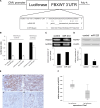MicroRNA-223 functions as an oncogene in human gastric cancer by targeting FBXW7/hCdc4
- PMID: 22270966
- PMCID: PMC11824240
- DOI: 10.1007/s00432-012-1154-x
MicroRNA-223 functions as an oncogene in human gastric cancer by targeting FBXW7/hCdc4
Abstract
Aims: The aim of this study was (a) to determine the role of micro-223 (miR-223) in gastric cancer and (b) to elucidate its regulatory mechanism on the FBXW7/hCdc4 gene.
Materials and methods: Artificial miR-223 and control oligonucleotide was transfected into gastric cancer cell line SGC7901 by using Lipofectamine2000. Apoptosis of miR-223 group and control group cells was analyzed by flow cytometry, and 3-(4,5-dimethylthiazol-2-yl)-2,5-diphenyl-tetrazolium bromide and colony formation assays were performed to detect the cell viability, to survey migration of miR-223 group and control group cells; scratch wound-healing motility assays, Transwell Assay, and Western blot test were performed to measure the variance of hFBXW7. Luciferase Reporter Assay, which was done by pLUC-hFBXW7 WT-3'-UTR co-transfected with pLMP-hsa-miR-223 or pLMP plasmid (as control) into HEK293T cells, used to detect whether hFBXW7 is a direct target gene of miR-223. Gastric cancer cell line SGC7901 transfected with miR-223 or control oligonucleotide was resuspended in ECM gel and then was injected into the flank of nude mice, 4 weeks later, the nude mice were euthanized. The tumors were excised then were measured and weighted. SYBR-Green I-based real-time RT-PCR study was used to detect the level of miR-223 in 22 gastric cancer tissue and corresponding gastric mucosa tissues. Immunohistochemical method was applied to detect the protein of hFBXW7.
Results: Gastric cancer cell line SGC7901, transfected with miR-223, showed significant reduction in cellular apoptosis and increased proliferation and invasion in vitro. Similar results were found in tumorigenesis assays performed in nude mice. Moreover, 19 of 22 cancer tissue samples highly expressed miR-223, when compared with patient-matched normal gastric mucosa. Specifically, patients with lymph node metastasis or metastatic disease (M1) at an advanced pathological stage showed significantly higher expression of miR-223. FBXW7/hCdc4 protein (FBW7) levels in gastric cancer cases were inversely correlated with miR-223 expression. Overexpression of miR-223 in gastric cancer cell lines decreased FBW7 expression at the translational level and decreased FBXW7/hCdc4-driven luciferase-reporter activity.
Conclusion: In summary, the data indicated that miR-223 targets FBXW7/hCdc4 expression at the post-transcriptional level and appears to regulate cellular apoptosis, proliferation, and invasion in gastric cancer. MiR-223 may serve as a novel therapeutic target in gastric cancer.
Conflict of interest statement
We declare that we have no conflict of interest.
Figures







Similar articles
-
Caveolin-1 inhibits the proliferation and invasion of lung adenocarcinoma via EGFR degradation.Sci Rep. 2025 Jul 1;15(1):21654. doi: 10.1038/s41598-025-05259-8. Sci Rep. 2025. PMID: 40594106 Free PMC article.
-
MicroRNA library-based functional screening identified miR-137 as a suppresser of gastric cancer cell proliferation.J Cancer Res Clin Oncol. 2015 May;141(5):785-95. doi: 10.1007/s00432-014-1847-4. Epub 2014 Oct 24. J Cancer Res Clin Oncol. 2015. PMID: 25342326 Free PMC article.
-
LncRNA PCED1B-AS1 mediates miR-3681-3p/MAP2K7 axis to promote metastasis, invasion and EMT in gastric cancer.Biol Direct. 2024 May 2;19(1):34. doi: 10.1186/s13062-024-00468-z. Biol Direct. 2024. PMID: 38698487 Free PMC article.
-
Diagnostic accuracy of endoscopic ultrasonography (EUS) for the preoperative locoregional staging of primary gastric cancer.Cochrane Database Syst Rev. 2015 Feb 6;2015(2):CD009944. doi: 10.1002/14651858.CD009944.pub2. Cochrane Database Syst Rev. 2015. PMID: 25914908 Free PMC article.
-
Cost-effectiveness of using prognostic information to select women with breast cancer for adjuvant systemic therapy.Health Technol Assess. 2006 Sep;10(34):iii-iv, ix-xi, 1-204. doi: 10.3310/hta10340. Health Technol Assess. 2006. PMID: 16959170
Cited by
-
MicroRNA-25 promotes gastric cancer proliferation, invasion, and migration by directly targeting F-box and WD-40 Domain Protein 7, FBXW7.Tumour Biol. 2015 Sep;36(10):7831-40. doi: 10.1007/s13277-015-3510-3. Epub 2015 May 6. Tumour Biol. 2015. PMID: 25944166
-
Visceral Adipose MicroRNA 223 Is Upregulated in Human and Murine Obesity and Modulates the Inflammatory Phenotype of Macrophages.PLoS One. 2016 Nov 3;11(11):e0165962. doi: 10.1371/journal.pone.0165962. eCollection 2016. PLoS One. 2016. PMID: 27812198 Free PMC article.
-
MicroRNAs in tumorigenesis, metastasis, diagnosis and prognosis of gastric cancer.Cancer Gene Ther. 2015 Jun;22(6):291-301. doi: 10.1038/cgt.2015.19. Epub 2015 May 22. Cancer Gene Ther. 2015. PMID: 25998522 Review.
-
Overexpression of miR-223 correlates with tumor metastasis and poor prognosis in patients with colorectal cancer.Med Oncol. 2014 Nov;31(11):256. doi: 10.1007/s12032-014-0256-5. Epub 2014 Oct 1. Med Oncol. 2014. PMID: 25270282
-
Targeting the ubiquitin pathway for cancer treatment.Biochim Biophys Acta. 2015 Jan;1855(1):50-60. doi: 10.1016/j.bbcan.2014.11.005. Epub 2014 Dec 4. Biochim Biophys Acta. 2015. PMID: 25481052 Free PMC article. Review.
References
-
- Akhoondi S, Sun D, von der Lehr N, Apostolidou S, Klotz K, Maljukova A, Cepeda D, Fiegl H, Dafou D, Marth C, Mueller-Holzner E, Corcoran M, Dagnell M, Nejad SZ, Nayer BN, Zali MR, Hansson J, Egyhazi S, Petersson F, Sangfelt P, Nordgren H, Grander D, Reed SI, Widschwendter M, Sangfelt O, Spruck C (2007) FBXW7/hCDC4 is a general tumor suppressor in human cancer. Cancer Res 67(19):9006–9012 - PubMed
-
- Alvarez-Garcia I, Miska EA (2005) MicroRNA functions in animal development and human disease. Development 132(21):4653–4662 - PubMed
-
- Bartel DP (2004) MicroRNAs: genomics, biogenesis, mechanism, and function. Cell 116(2):281–297 - PubMed
-
- Behm-Ansmant I, Rehwinkel J, Izaurralde E (2006) MicroRNAs silence gene expression by repressing protein expression and/or by promoting mRNA decay. Cold Spring Harb Symp Quant Biol 71:523–530 - PubMed
Publication types
MeSH terms
Substances
LinkOut - more resources
Full Text Sources
Medical

